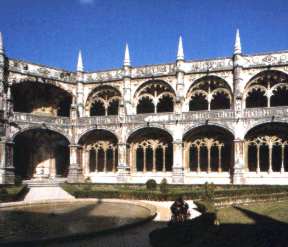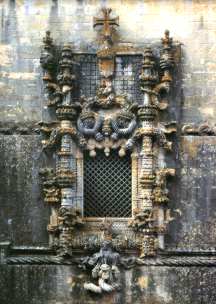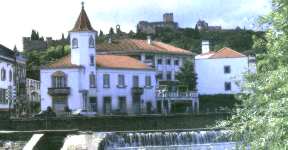|
|
|
|
WORLD HERITAGE SITES IN PORTUGAL
TOMAR
CASTELO TEMPLARIO AND CONVENTO DA ORDEM DE CRISTO DE TOMAR
In I983, UNESCO classified the Templar Castle and the Convent of the Knights of Christ in Tomar, a unique monument in the history of the western world, as world heritage. Quite probably built on a site of Roman worship, as is borne out by the stone taken from the sacrificial altar to the ''Genio Municipi'' and laid at the base of the Templar tower, this vast monument illustrates seven centuries of Portugal's history and contains important mementoes of decisive moments in the history of the western world.
At the very beginning of the kingdom of Portugal, D. Teresa and later her son, Afonso Henriques, our first king, successively bestowed upon the Knights of the Temple of Jerusalem vast tracts of land between the Mondego and Tagus rivers. Legend has it that, on reaching this region, the Knights had the vision to choose a hill on which to establish a castle and the name that they were to give to it: Tomar. The year was 1160 and D. Gualdim Pais, the Provincial Master of the Order of the Temple, ordered the castle to be built and the region to be settled. This was the beginning of the town of Tomar.

In order to establish an easy cohabitation between the town and the convent of the Knights Templar, the castle was built in three distinct walled enclosures, surrounded by an extensive outer wall. The largest enclosure, which faced southwards, was the walled town, whose gateway overlooked the area known as Sete Montes. In the sixteenth century, the town was emptied of its inhabitants and transformed into kitchen gardens and orchards for the monks of the Order of Christ. In recent times, the vegetable gardens have been replaced by the Parque do Laranjal, where, amidst footpaths, walls and terraces, the visitor can find evidence of the old town in the stones of the doorways and windows that have been preserved by time.To the north of the town and separated from it by a vast open space was the Templars' palace. There, to the east, was the very heart of the fortress: the citadel, a small fort built around the keep. This was also connected to the Charola or Rotunda, an octagonal, fortified church, a jewel of sacred architecture that was itself based on the temple erected by Constantine over the Holy Sepulchre in Jerusalem.
Despite the extinction of the Order of the Temple in I314 as a result of its persecution by the French king Philip IV, the Fair, the Templars were able to continue their holy mission of Chivalry in Portugal, with the full approval of the king D. Dinis, who after several years of negotiation with the Holy See founded the Militia of the Knights of Christ in 1319. The new order took over the personnel and property of the extinct order, enjoying its privileges and embracing the spirit of its mission. Outwardly, the main sign marking the change was to be seen in the Order's cross, which now had straight arms instead of the curved arms of the Templar cross.
Together with Prince Henry the Navigator, the son of D. Joao I, the new military Order began to prepare the Portuguese nation for the great enterprise of the maritime discoveries of the fifteenth and sixteenth centuries.
The lay master transformed the knights into navigators whose mission was to expand the kingdom and spread the faith through the maritime discoveries. This was why the caravels bore the Cross of the Knights of Christ on their sails, and this sign was to be carved into various stone landmarks all around the world.

Their history-making exploits were recorded in the architecture of the Convent, bearing testimony to the epochs and the men that ruled over the destiny of the Portuguese nation. The small Gothic cloister that the Prince ordered to be built in the old Templar enclosure, next to the Charola, as the burial ground for the great dignitaries of the Order, and the gallery that he had built above the original Templar cloister (now known as the “Laundry Cloister”) to connect the conventual apartments with the Charola speak to us most eloquently of his time, as do the ruins of the ''Prince's Palace''.After the sixteenth century, the entrance to the Sanctuary was moved from the east to the south, and it is through here that the visitor to the monument now passes, a magnificent doorway built at the behest of D. Manuel I, the first king to become the master of the Order of Christ. At the time when the Knights of Christ were braving the seas of India, D. Manuel ordered the Templars' church to be expanded westwards, spreading beyond the castle limits and opening up the Charola to add on to it a magnificent nave which housed the choir and the sacristy, becoming known as the chapter house.
A profuse and exuberant carved decoration blends in with the peculiar architecture of this nave, serving as the basis for a symbolic constructive language known nowadays as the ''Manueline style'', a language that uses a poem written in stone to express the beliefs and knowledge that the navigators of the Order of Christ had about the mysteries of life, beings, Man and God, about the things of the earth, sky and sea.
The whole of the west front of the Manueline nave, which contains the famous chapter house window is the supreme example of the mysticism of this Spiritual Chivalry, illustrating the mission that the Order of Christ had taken upon itself in embarking upon the great enterprise of the maritime discoveries. Amidst this emblematic decoration, certain features stand out in particular as figurative themes: the tree, its trunk and roots; the frequent presence of certain plant species, such as the acanthus, artichoke, cork-oak, rose-hips and even seaweed. Also quite remarkable in this astonishing work is the symbolism of the connections or vital functions expressed by grafts, ribbons, wickerwork laces, ropes and chains, fire and waves and also by fantastic or mythological creatures, such as the Chinese Dragon. Angels represent spiritual power, whilst kings represent temporal power, all being surmounted by the heraldic devices of the Order of the Knights of Christ, as shown in the Cross of the Order, in the royal coat of arms and armillary sphere, the emblem that D. Manuel adopted for his own house when he became the lay master of the Order of Christ.

D. Manuel was succeeded on the Portuguese throne by D. Joao III, who, imbued with the ideas of the Counter-Reformation of the Roman Church, introduced profound changes to the order, altering its rules with the aim of transforming its knights into monks and doing away with its military branch. It was after D. Joao's accession to the throne that a magnificent convent began to be built to the west, adjacent to the Castle and the building work that had been sponsored by D. Manuel. Work continued on the Joanine convent through several reigns until the eighteenth century, leaving behind extremely beautiful examples of the different artistic trends that occurred during that period. This was how the architecture of Tomar Castle and the Convento de Cristo came to include such a wide range of different features: examples of Romanesque art, with the Templars; Gothic and Manueline styles with the Discoveries; evolving thereafter to include the art of the Renaissance with the Joanine reformation and several aspects of mannerism, and culminating in the Spanish domination of the Three Philips (1580-1640). The baroque period is clearly illustrated in some building processes and architectural decorations, notably through the remarkable military hospital and new lodgings resulting from the re-establishment of the Knighthood as a lay society by D. Joao IV, at the height of the Restoration of Portuguese Independence.The nineteenth century also left evidence of its own particular aesthetic trends, after the extinction of the Order in I834, with the recently-created Count of Tomar partially transforming the south-west cloister of the Convent into a neo-classical palace, in which he himself took up residence. This heralded the beginning of the modern period, in which the memory of the Order of Christ persisted under the form of an honorary Order, of which the President of the Portuguese Republic is considered the Grand Master.
Text provided by the Portuguese Tourist Office